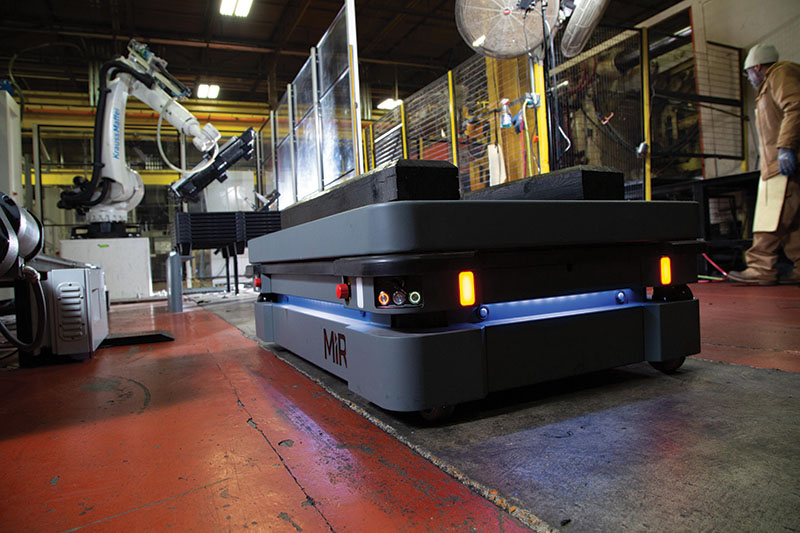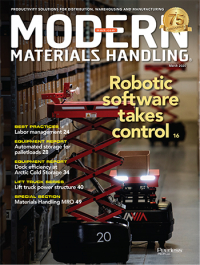Mobile robots solve labor and safety issues
Manager says new robots are the easiest part of a new fully automated production line.
At Cabka North America in St. Louis, Mo., workers at 11 injection molding machines spent their days unloading plastic pallets and manually trimming and stacking them for transport to the warehouse using forklifts or pallet jacks. The repetitive and physical work at the 400,000-square-foot facility made it difficult to retain workers, while forklifts on the floor lead to safety concerns. A new fully automated production line including mobile robots (Mobile Industrial Robots, or MiR) has improved safety and productivity.
To automate the process and improve safety, Cabka designed a fully automated production line. The new line includes a mobile robot and a six-axis robot to autonomously unload pallets from the injection molding machine, trim the pallets and load finished products onto the mobile robot. The robot transports the finished products out of the manufacturing floor to a separate staging area when the job is complete.
In the staging area, the pallets can be checked for quality and wrapped, and then forklifts can transport the finished pallets to the warehouse and loading docks without needing manufacturing workers. This allows Cabka to eliminate forklift traffic in the production area, replacing them with collaborative mobile robots.
The new line is intended to be the model for the eventual automation of all 11 production lines, with a fleet of mobile robots supporting them. In the new highly efficient manufacturing floor, mobile robots can go where they’re needed to keep production flowing. Cabka estimates the first robot travels about three miles a day supporting one production line. With 11 lines planned for autonomous material transport with multiple robots, workers and forklift drivers will be relieved from many miles of manual materials handling, allowing Cabka to redeploy those workers to higher-value tasks.
The robot’s user-friendliness is a key element of the project’s success, says Cabka project technician Craig Bossler, who also cites the robot’s cost-effectiveness, small footprint and safety features. In fact, the robots have proven to be the easiest part of the new automation project, even in an older facility with uneven floors, cracks and bumps.
“We are very happy with the payload,” Bossler says. “It’s handled everything that we can stack on top of it. It can make turns, go straight, hit bumps and handle all the imperfections in the floor while remaining stable. We haven’t found out how high we can go yet, but it’s very stable.”

Article Topics
Robotics News & Resources
AutoStore to launch U.S. headquarters in greater Boston region IFR: Robot installations by U.S. manufacturing companies up 12 percent last year Geek+ and System Teknik deploy PopPick solution for pharmacy group Med24.dk Materials Handling Robotics: The new world of heterogeneous robotic integration Walmart deploying autonomous lift trucks at four of its high-tech DCs 2024 Intralogistics Robotics Survey: Robot demand surges Autonomous mobile robots (AMRs) on a mission More RoboticsLatest in Materials Handling
UniCarriers Forklift joins Quality Equipment in opening celebration of new location Largest Automate on record opens in Chicago on Monday May 6th April manufacturing output recedes after growing in March Carolina Handling celebrates anniversary with 58 for 58 giveaway Q1 sees a solid finish with strong U.S.-bound import growth, notes S&P Global Market Intelligence AutoStore to launch U.S. headquarters in greater Boston region Trew expanding manufacturing and development campus in southwest Ohio More Materials HandlingAbout the Author
Subscribe to Materials Handling Magazine

Find out what the world's most innovative companies are doing to improve productivity in their plants and distribution centers.
Start your FREE subscription today.
April 2024 Modern Materials Handling

Latest Resources












